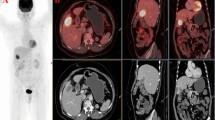Abstract
Background
Incidentally detected gall bladder carcinoma (IGBC) is occasionally encountered after cholecystectomy for benign gall bladder disease. Rarely these patients may present with port-site metastases (PSM) in follow-up. We retrospectively assessed the role of 18F-fluorodeoxyglucose positron emission tomography-computed tomography (FDG PET/CT) in them. We aimed to determine the clinical outcome and correlate the survival based on FDG PET/CT findings.
Material and Method
We did a single-center retrospective study in IGBC patients presented with histopathologically proven PSM. FDG PET/CT was done for restaging. The metastatic burden was evaluated. Survival after PSM and overall survival (OS) were assessed in different disease groups.
Results
A total of 22 patients (51.86 ± 12.04 years) were included in the study. The mean interval between LC and PSM was 336.7 ± 501.9 days. On FDG PET/CT, isolated single PSM was noted in 21 (95.5%) patients. Apart from PSM, abdominal lymph nodes, GB fossa lesion, and liver metastases were noted in the 10 (45.5%), 6 ( 27.3%), and 7 (31.8%) patients, respectively. FDG PET/CT revealed intra-abdominal disease and visceral metastasis in 11 (50%) and 10 (45.5%) patients. Nineteen (86.4%) patients died in follow-up with a median survival of 328.50 (225.25–804.0) day after PSM. Median OS after LC was 687.00 (362.50–1047.0) days. Patients with PSM plus disease (432.0 days, 255.9–608.1), extra-abdominal metastases (400.0 days, 316.9–483.1), and visceral metastases (400.0 days, 296.2–503.8) had significantly lower OS compared to isolated PSM (1763 days, p = 0.013), the intra-abdominal disease (996.0 days, 753.2–1238.8, p = 0.0340), and non visceral metastasis (807.0 days, 467.5–1146.4, p = 0.037).
Summary
IGBC presenting as PSM is a distinct clinical entity. FDG PET/CT as functional imaging evaluates the local and metastatic disease burden. There is significantly lower survival in patients with PSM plus disease, extra-abdominal metastases, or visceral metastases. FDG PET/CT was an important prognostic marker in these patients and could help in management.

Similar content being viewed by others
Abbreviations
- FDG-PET/CT:
-
18F-fluorodeoxyglucose positron emission tomography-computed tomography
- HPE:
-
Histopathology
- CaGB:
-
Carcinoma gall bladder
- OS:
-
Overall survival
References
Hundal R, Shaffer EA. Gallbladder cancer: epidemiology and outcome. Clin Epidemiol. 2014;6:99–109.
Misra S, Chaturvedi A, Misra NC, Sharma ID. Carcinoma of the gallbladder. Lancet Oncol. 2003;4(3):167–76.
Gonzalez-Escobedo G, Marshall JM, Gunn JS. Chronic and acute infection of the gall bladder by Salmonella Typhi: understanding the carrier state. Nat Rev Microbiol. 2011;9(1):9–14.
Kumar S, Kumar S, Kumar S. Infection as a risk factor for gallbladder cancer. J Surg Oncol. 2006;93(8):633–9.
Cavallaro A, Piccolo G, Di Vita M, Zanghì A, Cardì F, Di Mattia P, et al. Managing the incidentally detected gallbladder cancer: algorithms and controversies. Int J Surg. 2014;12(Suppl 2):S108–19.
Duffy A, Capanu M, Abou-Alfa GK, Huitzil D, Jarnagin W, Fong Y, et al. Gallbladder cancer (GBC): 10-year experience at Memorial Sloan-Kettering Cancer Centre (MSKCC). J Surg Oncol. 2008;98(7):485–9.
Siegel RL, Miller KD, Jemal A. Cancer statistics, 2017. CA Cancer J Clin. 2017;67(1):7–30.
Skalický T, Třeška V, Liška V, Molacek J, Fichtl J, Skalický A, al. Treatment of accidentally diagnosed gallbladder cancer after laparoscopic cholecystectomy. Clinics In Surgery [Internet]. 2018 Nov 1 [cited 2021 Jul 15];3(1). Available from: https://www.remedypublications.com/clinics-in-surgery-abstract.php?aid=3604
Cavallaro A, Piccolo G, Panebianco V, Lo Menzo E, Berretta M, Zanghì A, et al. Incidental gallbladder cancer during laparoscopic cholecystectomy: managing an unexpected finding. World J Gastroenterol. 2012;18(30):4019–27.
Z’graggen K, Birrer S, Maurer CA, Wehrli H, Klaiber C, Baer HU. Incidence of port site recurrence after laparoscopic cholecystectomy for preoperatively unsuspected gallbladder carcinoma. Surgery. 1998 Nov;124(5):831–8.
Berger-Richardson D, Chesney TR, Englesakis M, Govindarajan A, Cleary SP, Swallow CJ. Trends in port-site metastasis after laparoscopic resection of incidental gallbladder cancer: a systematic review. Surgery. 2017;161(3):618–27.
Agarwala V, Ramaswamy A, Dsouza S, Pande N, Goel M, Patkar S, et al. Resection of isolated port site metastasis in gall bladder cancers-careful selection and perioperative systemic therapy may improve outcomes. Indian J Surg Oncol. 2018;9(3):427–31.
Hu J-B, Sun X-N, Xu J, He C. Port site and distant metastases of gallbladder cancer after laparoscopic cholecystectomy diagnosed by positron emission tomography. World J Gastroenterol. 2008;14(41):6428–31.
Sharma P, Chatterjee P. Late port site metastasis from occult gall bladder carcinoma after laparoscopic cholecystectomy for cholelithiasis: the role of (18)F-FDG PET/CT. Nucl Med Mol Imaging. 2014;48(4):317–20.
Delbeke D, Coleman RE, Guiberteau MJ, Brown ML, Royal HD, Siegel BA, et al. Procedure guideline for tumor imaging with 18F-FDG PET/CT 1.0. J Nucl Med. 2006 May;47(5):885–95.
Søreide K, Guest RV, Harrison EM, Kendall TJ, Garden OJ, Wigmore SJ. Systematic review of management of incidental gallbladder cancer after cholecystectomy. Br J Surg. 2019;106(1):32–45.
Lundberg O, Kristoffersson A. Port site metastases from gallbladder cancer after laparoscopic cholecystectomy. Results of a Swedish survey and review of published reports. Eur J Surg. 1999 Mar;165(3):215–22.
Ethun CG, Postlewait LM, Le N, Pawlik TM, Poultsides G, Tran T, et al. Routine port-site excision in incidentally discovered gallbladder cancer is not associated with improved survival: a multi-institution analysis from the US Extrahepatic Biliary Malignancy Consortium. J Surg Oncol. 2017;115(7):805–11.
Chauhan A, Ganguly M, Sharma AK. Isolated port site metastases in carcinoma gallbladder: does it represent better prognosis? Indian J Surg Oncol. 2017;8(3):258–62.
Author information
Authors and Affiliations
Corresponding author
Ethics declarations
Conflict of Interest
The authors declare no competing interests.
Additional information
Publisher's Note
Springer Nature remains neutral with regard to jurisdictional claims in published maps and institutional affiliations.
Rights and permissions
About this article
Cite this article
Saini, V.K., Hassan, A., Singh, A.K. et al. Port-Site Metastases in Incidentally Detected Carcinoma Gall Bladder: Role of 18F-FDG PET/CT and Patient Outcome. J Gastrointest Canc 53, 16–21 (2022). https://doi.org/10.1007/s12029-021-00746-3
Accepted:
Published:
Issue Date:
DOI: https://doi.org/10.1007/s12029-021-00746-3




